Beijing-Ethnic Minority Villages-Li River Cruise Package Tour

|
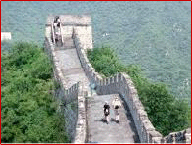
Great Wall, Beijing
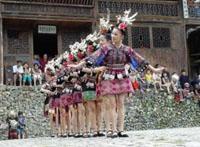
Kaili, Guizhou Province
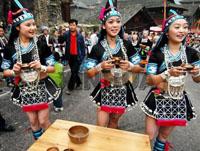
Miao Village
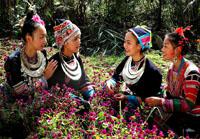
Dong Girls
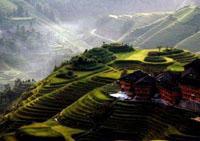
Longji (Dragon's Bone)
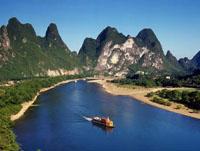
Guilin
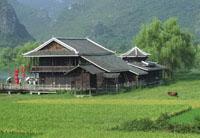
Yangshuo
|
|
Beijing-Ethnic Minority Villages-Li River Cruise
China Cultural
Heritage Tour (11-day)
Highlights:
• Explore the remote and charming villages of the Miao and
Dong minority ethnic groups, which are largely untouched by the
modern world
• Cruise down the stunning Li River (Lijiang), one of the top
attractions in all of China, and explore the hidden lush region
of Yanagshuo, a melting pot of cultures from all over Asia
• Visit Beijing, China’s most important city. There you will see
the Great Wall, Forbidden City and Tian’anmen Square, among
other top sights
Standard
Tour and Luxury Tour Packages Available.
B=(Breakfast) L=(lunch) D=(dinner) DEPARTURE: Daily |
|
|
| |
TOUR ITINERARY |
 |
Tour
code:
P-BEL |
|
Day 1: Airport
Transfer
When you arrive in Beijing, we will meet you and
drive you to your accommodation, a 4-star hotel in
the heart of Beijing, The rest of your day is up to
your discretion. |
Day 2: Beijing-Tian’anmen
Square+Forbidden City+ Temple of Heaven +Lama Temple
(B, L)
Our guide will meet you at your
hotel between 7:30-800am, and from we will start our
sightseeing. Our first stop is at Tian’anmen Square.
The largest public square in the world, Tiananmen
Square is seen as China’s political center. Its
grounds have seen some turbulent moments, from the
May 4th Movement of 1919 to the political turmoil of
1989. The south of the square is marked by the
Chairman Mao Memorial Hall, while the center of the
square is dominated by the Monument to the People’s
Heroes, an imposing 10-story granite obelisk. To the
east is the National Museum of China, and to the
west is the Great Hall of the People, home to
China’s legislative bodies. The north of the square
is dominated by the Gate of Heavenly Peace, known
for its iconic portrait of Mao Zedong, and is the
national emblem of China.
After walking across the square we will enter the Forbidden City (known in Chinese as Gu Gong), the
largest surviving palace complex and the former home
of the emperors of the Ming and Qing Dynasty. The
Forbidden City is one of the greatest attractions in
the world. Built by the third Ming emperor between
1406-1422, the Forbidden City served as the official
residence to the Emperor of China until the last
emperor, Puyi, was forced to evacuate in 1924. The
Forbidden City is divided into two parts. The
southern section, or the Outer Court was where the
emperor exercised his supreme power over the nation.
The northern section, or the Inner Court was where
he lived with his royal family. Consisting of 980
buildings and with 8,707 bays of rooms, the
Forbidden City is the best example of classical
Chinese architecture in the world, and is a wonder
to behold.
We will then drive to the Temple of Heaven park. The
complex was visited by the Emperors of the Ming and
Qing dynasties for annual ceremonies of prayer to
Heaven for good harvest. The Temple of Heaven park
is best known for the Hall of Prayer for Good
Harvests, an iconic building famed for its
magnificent triple-gabled circular roof. You will
also have an opportunity to walk the same imperial
walkway that the same emperors walked hundreds of
years ago in their holy rites. You will also see
Beijing’s senior citizens using the park grounds for
everything from tai chi and ballroom dancing to
bullwhip practice! If you’d like we can join in for
their exercises, known as Tai Chi.
After visiting the Temple of Heaven we will go to
visit the Lhama Temple. Other than the temples in
Tibet this is the best Buddhist temple in China.
Work on the Lhama Temple originally began in 1694
during the Qing dynasty. It served as an official
residence for court eunuchs. It was then converted
into the home of the Prince Yong, a son of the
Kangxi Emperor and himself the future Yongzheng
Emperor. It was converted into a lamasery after his
ascension to the throne in 1722. Today the Lhama
Temple still functions as a monastery and temple of
the Geluk School of Tibetan Buddhism. Walking
through the temple your senses will be enveloped by
the incenses and the chanting of the visiting monks
and other followers. The rear Pavilion of Ten
Thousand Happinesses features a 26m tall statue of
the Maitreya Buddha cared from a single piece of
white sandalwood. It is one of three artworks in the
Lhama Temple that were included in the Guiness Book
of World Records, and it is not to be missed on your
visit.
We will then drop you off at your hotel, and the
night is up to your discretion. |
Day 3: Beijing-Mutianyu Great
Wall-Ming Tombs-Spirit Way-Olympic Green (B,L)
After a morning pickup at your hotel we will drive
directly to the Great Wall at Mutianyu. As one of
the best-preserved parts of the Great Wall, the
Mutianyu section of the Great Wall used to serve as
the northern barrier defending the capital and the
imperial tombs. First built in the mid-6th century
during the Northern Qi, Mutianyu Great Wall is older
than the Badaling section of the Great Wall. In the
Ming dynasty, under the supervision of General Xu Da,
construction of the present wall began on the
foundation of the wall of Northern Qi. In 1404, a
pass was built in the wall. In 1569, the Mutianyu
Great Wall was rebuilt and till today most parts of
it are well preserved.
Compared with other sections of Great Wall, the
Mutianyu Great Wall possesses unique characteristics
in its construction. Watchtowers are densely placed
along this section of the Great Wall - 22
watchtowers on this 2,250-meter-long stretch. The
Mutianyu Pass consists of 3 watchtowers, one big in
the center and two smaller on both sides. Standing
on the same terrace, the three watchtowers are
connected to each other inside and compose a rarely
seen structure among all sections of Great Wall.
For the afternoon, we will make the short trip to
the Ming Tombs. The Ming Tombs, about 50 km/31 miles
from Beijing, are where 13 emperors of the Ming
Dynasty (1368-1644) are buried. This site was
carefully chosen for its feng shui principles by the
third Ming emperor Yongle (who also moved the
capital from Nanjing to Beijing and began
construction on the Forbidden City). The tomb we
will visit, Dingling, is the tomb of the Wanli
Emperor. It is the only one of the Ming Dynasty
Tombs to have been excavated. It also remains the
only imperial tomb to have been excavated since the
founding of the People's Republic of China, After
viewing the tombs, we will head to the “Shenlu”, or
the Spirit Way. The Spirit Way leads into the
complex, lined with statues of guardian animals and
officials, with a front gate consisting of a
three-arches, painted red, and called the "Great Red
Gate". The Sacred Way, starts with a huge stone
memorial archway lying at the front of the area.
Constructed in 1540, during the Ming Dynasty, this
archway is one of the biggest stone archways in
China today.
On our way back to the city we will stop off at one
more sight, this one highlighting the more modern
aspects of Beijing. The Olympic Green was the center
of the event that captivated the world for two weeks
in August of 2008. The highlights include the Bird’s
Nest (officially known as the Beijing National
stadium) and the Water Cube (the Beijing National
Aquatics Center).
After walking the Olympic Green we will take you
back to your hotel, completing the day’s travels.
The night is at your discretion.
Optional: If you’d like, you can choose one of our 1
day Great Wall hiking tours and do that instead for
today. |
Day 4: Beijing-Guiyang (by
air) (B, L)
You will be drive to the airport,
and from there you will fly to Guiyang, the capital
of Guizhou Province, in southwest China. You will be
met at the airport by out English-speaking guide,
and you will then be taken to your hotel for the
evening. The rest of the night is to be spent at
your discretion. |
Day 5: Guiyang-Kaili (B, L)
In the morning we will head for
Kaili, a region of Guizhou where 25% of the Miao
ethnic group live. Here we will explore the Miao
ethinc minority villages.The Miao ethnic group is
both mysterious and exciting. The Miao people are
identified by their dialect, dress, location and
other customs. In dress there are Long Skirt Miao,
Short Skirt Miao, Black Miao, Flowery Miao and Long
Horned Miao. By location there are River Miao and
Mountain Miao. The villagers in Langde wear long
skirts, hence they are "Long Skirt Miao". The Miao
style houses "Diaojiaolou" and its featured and
creative festivals will make you spellbound.
First, we will go to the Shiqiao Village, and learn
about the Miao’s traditional way of making paper
from the back of the mulberry tree, and then at the
Qiaomen Village, where we will watch how the Miao
people produce the cloth for their colorful outfits.
We will spend the day in a local inn, and dinner
will included some basic Miao cuisine, which
involves lots of deep-fried foods. |
Day 6: Kaili-Rongjiang (B, L)
In the morning we will travel to
Rongjiang, about 170 km (about 106 miles) from Kaili.
It serves as the base to visit the surrounding Dong
and Miao villages.
We’ll head first to the Jidao Short Skirt Miao
Village, which is well known in the region of the
silver ornaments produced by the craftsmen here.
Jidao Short Skirt Miao village is set in idyllic
surroundings and populated by ethnic Miao people.
Village life is simple and children play as their
parents tend fields of lush, organically grown
vegetables surrounded by towering pine forests.
Elderly women stoke fires in traditional wooden
houses, some hundreds of years old. It is so poor,
mountainous and remote that the tranquility here is
not yet broken by a flood of rich Chinese tourists
and foreign visitors. Then we’ll go to the Datang
Short Skirt Miao Village. You will be greeted by its
friendly villagers and drink the block way wines
before entering the village. Its silver ornaments
will leave you a deep impression.
Then we’ll explore the Chejiang Dong People’s
Village, They are three villages of varying size,
among which Zhanglu village is the most well known
as the cradle of standard Dong dialect. We will
spend the night at an inn in Rongjiang. |
Day 7:
Rongjiang-Zhaoxing (B, L)
After breakfast in the inn we will
make our way to Zhaoxing and the Basha Miao Village
Zhaoxing is home to some of the largest villages in
Guizhou. Basha is a very special and old Miao ethnic
village. The villagers still practice their unique
traditions dating back to the Qin Dynasty (221-206
BC). Basha Village is almost untouched by China’s
rapid modernization. Residents there still live in
their wooden houses, practice centuries-old customs
and have their own unique beliefs. Basha is a
relatively big village with 2,140 residents, but
they rarely connect with the outside world. They
live in their community and lead a self-sufficient
life in their mountainous surroundings.
Then we will learn more about the Dong minority
ethnic group at the Dong People Village, which is
also in Zhaoxing. The Dong ethnic minority lives
primarily in the border regions between Guizhou,
Hunan and Hubei Provinces, and it was during the
Tang Dynasty (618-907), that this minority separated
from the mixed minority 'Bai Yue', naming themselves
Dong. The Dong people work on agriculture, forestry
and the industrial arts. The women are adept at
spinning and embroidering and on the brocade. The
staple food of the Dong ethnic minority is rice,
millet, corn, wheat sorghum and glutinous rice. Oil
tea is their favorite drink, which can also be their
breakfast, whose ingredients include peanuts,
sesame, soybean, tea leaves, and so on.
There are five sections which make up the village,
namely ren (meaning benevolence), yi (meaning
justice), li (meaning courtesy), zhi (meaning
wisdom) and xin (meaning faith). One clan lives in
every section, and every clan has built its own drum
tower. A street runs from east to west in the
village. The houses are typical Dong dwellings with
stilts and roofs of black tiles. The features of the
Dong architecture are also demonstrated in the five
wooden drum towers, the four magnificent wooden
roofed flower bridges and five performance stages.
We will stay in an inn in the village, and you can
spend your night further exploring the village. |
Day 8: Zhaoxing-Sanjiang (B,
L)
In the morning we will drive to
Sangjiang to visit the Tang’an Dong Village. The
village is renowned as the “most primitive Dong
Village" in China. The village is 5 km (3 miles)
from the Zhaoxing Village. The country road
stretches to the village, which is located on a
mountainside and is surrounded by paddy field and
lush greens. There are about 800 people and 160
households in the village. The village has a long
history, though it hasn’t got any written records of
its history. There are village gate, drum tower,
drama tower, ancient graveyard, ancient well, and
water-powered roller for grinding grain, barns and
the pit to worship the female ancestors of Dong
people. There are also ancient stone paths and wood
houses in the village. All of these make it a
perfect place for people to return to nature.
Another highlight of Sanjiang that we will explore
is the Chengyang Wind and Rain Bridge. It was built
in 1916, and it is the best one among the wind and
rain bridges in Dong stockade villages. At present,
it is the largest wind and rain bridge. We will
spend the night at an inn in Sanjiang, and you can
spend the evening at your own leisure. |
Day 9: Sanjiang-Longsheng-Guilin
(B, L)
After an early wake-up we will make
the drive to Longsheng. By foot we will walk up and
down the Dragon’s Backbone Rice Terraces. A vast
region of rice terraces stretches layer upon layer,
coiling around from the base of Longji (the dragon's
backbone) Mountain to its summit; this is the most
amazing terrace in China. The Dragon's Backbone Rice
Terraces is a beautiful natural picture. The linked
together rice terraces vary from season to season.
In spring, the water is irrigated into the fields
and the terraces look like great chains or ribbons
hung on the hillsides. When the onset of summer,
green waves rush continuously down the mountainside
from the heaven. The theme of autumn is the harvest,
with the mountainside decorated with the gold of
ripened millet. Coming into winter, the whole
mountain will be covered with white snow, just like
dragons playing with water.
Dotting all along the rice terraces are the peoples
and villages of the Zhuang and Yao minority groups.
The women dress in unique and colorful costumes,
singing and dancing. Guests also can join in with
them to enjoy the original Zhuang life and culture,
and even stay with local families enjoying both the
Longji tea and the Longji wine.
We will stay here most of the day in order to better
understand the Zhuang’s and Yao’s fascinating way of
life. In the late afternoon we will drive back to
your hotel in Guilin.
You can use your free time at night to walk down
Guilin’s streets and catch the folk dancing and
singing going on all around you. |
Day 10:
Guilin-Yangshuo (B, L)
Today you will be cruising down one
of the world’s most stunning rivers, the Li.
Gorgeous karst peaks give you surprises at each bend
of the limpid river under the blue sky. Water
buffalo patrol the fields, peasants reap rice
paddies, school kids and fisherman float by on
bamboo rafts. With its breathtaking scenery and
taste of a life far removed from the concrete
metropolis, the scenery along the Li River become
one of China's top tourist destinations. Some of the
highlights you will see on your 7-8hour cruise will
be Elephant Trunk Hill, a hill resembling an
Elephant taking water from its trunk, Pagoda Hill,
just a few minutes away from the Elephant Trunk
Hill, Daxu Town, an ancient river town, and of
course you will also see local fisherman and workers
over their normal course of work. The cruise down
the Li River offers a fascinating insight into the
lives of the local population here.
Our cruise will terminate at Yangshuo, a lush and
exotic county that includes minority groups from all
over Asia. In the afternoon we will rent bikes and
ride onto the country roads, lanes, and tracks,
through the paddy fields orchards that surround the
misty mountains. To cool off after our ride, we will
float on bamboo rafts down the Yulong River. The
languid river is surrounded by a primitive, but
pure, natural landscape, along with green bamboo
forests and rolling hills. Visitors to the area will
delight in the picturesque scenes of simple rural
life: bamboo waterwheels irrigating the paddy
fields; village girls hand washing clothes outside
of their cottages with smoke curling upward from the
chimneys; old men fishing in the river; flocks of
ducks swimming in the pond.
The night is up to you, but we recommend spending
some time at West Street, the oldest street in
Yangshuo, and features an interesting mix of
traditional shops and modern bars. |
Day 11 Yangshuo-Guilin-depart Guilin (B)
You will be driven back to Guilin, and from the
Guilin airport you will home or to your next
destination, ending your tour with us. |
|
Stuff to bring:
• Sturdy shoes or boots, sunglasses and sunscreen
• Bug spray and any other items needed in dealing with the tropical heat
• Tips for a job well done by your guides and drivers, money for any
personal expenses not mentioned
|

